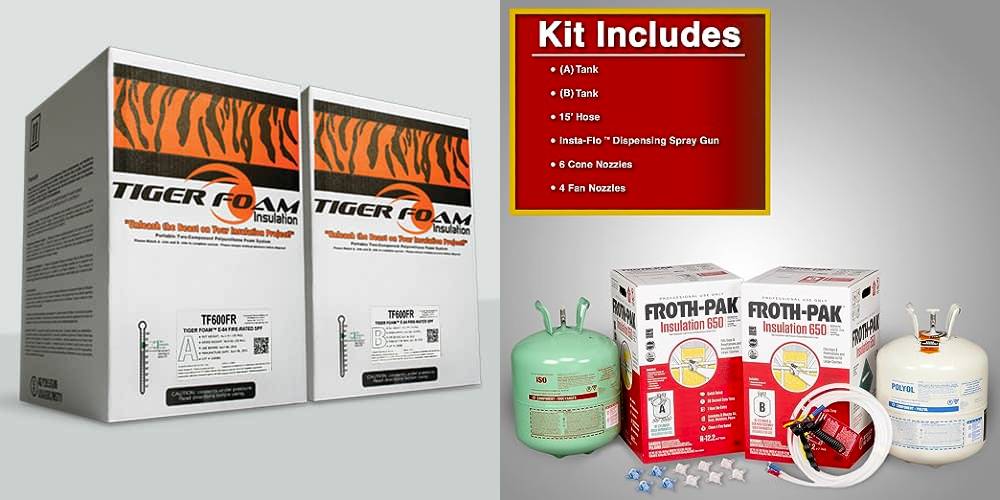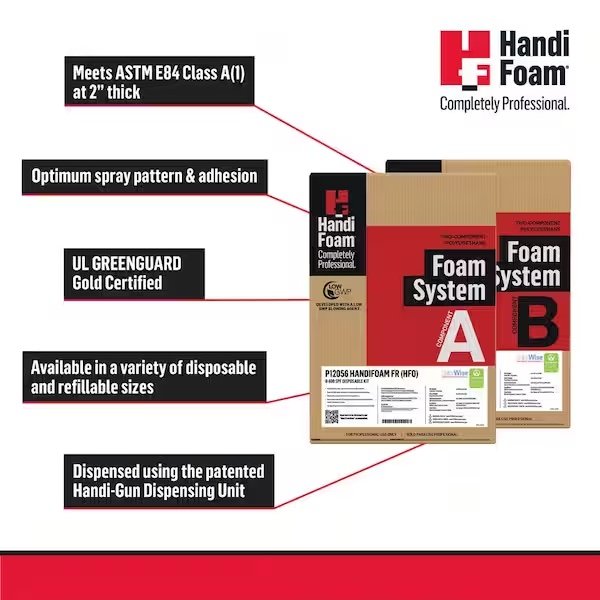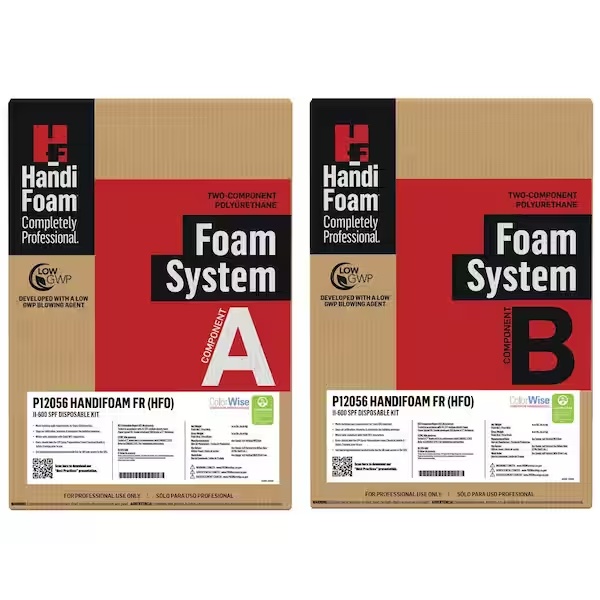 If you have a spray foam insulation job to do, you’re likely to run across two of the more dominant brands on the market, Tiger Foam and Froth-Pak. They’re well-known and widely available, and both brands make a good product.
If you have a spray foam insulation job to do, you’re likely to run across two of the more dominant brands on the market, Tiger Foam and Froth-Pak. They’re well-known and widely available, and both brands make a good product.
But there are some real differences between these two spray foam kits, ranging from how effective they are, how easy they are to work with, and how they’ll impact your bottom line.
Today we’re going to be comparing the products pros are most likely to be using, the Tiger Foam HFO E-84 Fast Rise 600 Board Foot Kit, and the Low GWP Froth-Pak™ 650 Spray Foam Insulation Kit. Both of these spray foam kits will come with everything you need to tackle your job, and both will give you about 600 board feet of coverage (or slightly more with Froth Pak) at 1 inch thickness.
We’ll tell you right up front that if you have to choose between Tiger Foam and Froth Pak, we think Froth Pak is the better bet. There’s a big BUT on that recommendation, though.
After comparing stats on the top spray foam kits available today, we actually recommend a third product — the HandiFoam 600 Closed Cell Spray Foam Kit — especially for pros. It’s going to outperform both Tiger Foam and Froth-Pak in almost every measure, and will save you money in the long run, especially if you’re buying in bulk.
Check out the HandiFoam 600 Closed Cell Spray Foam Kit for just $777.00 for one unit and larger discounts for more units.
Read on to learn all about these three closed cell foam products, and why we think pitting HandiFoam vs Frost Pak, or HandiFoam vs Tiger Foam, will leave HandiFoam on top.
How We Judged the Competitors
There are a lot of potential ways to compare closed cell spray foam kits, but we think the most important factors are the most basic ones.
- How well does it insulate?
- How cost effective is it?
- How easy is it to work with?

The first factor is pretty obvious. If you’re looking for spray foam insulation, you want it to insulate well — that’s its primary job. Any quality pro or DIY spray foam insulation will perform better than blown-in fiberglass, for example, but there are real differences in the insulation values of various spray foam products. Those differences really start to add up when you apply multiple layers, as many jobs require.
Price is another obviously important factor. Spray foam is already one of the more expensive insulation choices, and if you’re working on a large project, costs can quickly become significant.
The last point — ease of use — involves a few different moving parts. Applying spray foam is fairly straightforward, and all of these brands use the same simple spray mechanism, but there are other considerations. We’ll review how long each brand of spray foam insulation needs to cure before it can be worked with, why that’s important, and take a look at the accessories included with each kit. So with those features in mind, let’s turn our attention back to our comparisons.
Insulation Value
Any spray foam insulation you buy should display its R-value, which is a standard measurement of how effectively the material resists heat transfer. R-values will usually be attached to some measurement of thickness, i.e. “R-X per inch.” Most products will advertise both an initial R-value and an “aged” R-value, and it’s important to pay attention to both.
That’s because the gasses that fill the foam initially — called propellents — insulate more effectively than air. As the propellants dissipate and are replaced by regular old air, usually during the first 60-90 days, you’ll lose some insulating ability. Ultimately, the aged R-value is the one to be most concerned about.
Tiger Foam
Tiger Foam has the lowest initial R-value compared to either Froth Pak or HandiFoam, at R-6.50 per inch of material. The “aged” R-value of Tiger Foam then drops to R-6.1 after 90 days. That’s a pretty significant reduction.
Note: All of the DIY spray foam kits we’re discussing in this article come with roughly 600 board feet of coverage capacity. You may also see kits in other sizes — commonly 200 board feet — but the R-values for both will be the same. You’ll just get less coverage.
Froth Pak
Froth Pak has Tiger Foam beat when it comes to initial R-value per inch. This spray foam insulation starts off with an R-6.7, a few tenths of a point higher than Tiger Foam.
Froth Pak’s aged R-value then drops dramatically, though. According to the manufacturer, Froth Pak’s R-value lands at R-6.2 after 90 days, just a point above that of Tiger Foam.
So in this head-to-head, Froth Pak comes out on top, with an aged R-value of 6.2 vs Tiger Foam’s R-6.1. In this comparison, Froth Pak is your best bet.
HandiFoam

As we mentioned at the top of this article, though, we think shoppers should consider all their options. And HandiFoam has both of its competitors beat in the very important insulation category.
HandiFoam’s R-value begins at R-7.1 per inch, better than both of the products in this comparison. More importantly though, its aged R-value is R-6.44 per inch. That R-6.44 is significantly greater than Tiger Foam, at R-6.1 per inch, and also higher than Froth Pak’s R-6.2 aged value.
If those differences don’t sound like a lot, keep in mind that these values apply to each inch of closed cell foam, and many jobs will involve the application of several inches of material. That means each fraction of difference will be multiplied by the number of inches applied.
Best Value for Spray Foam Insulation
There’s no getting around the fact that spray foam insulation isn’t cheap. The cost is justified by the benefits — like energy savings after installation, better durability, and a generally superior product than older types of insulation — but each time you install a spray foam kit is an investment.
As with most things, if you see a price that’s too good to be true, beware: spray foam kits do have a shelf life, and some disreputable vendors may try to sell spray foam kits that are past their prime.
Tiger Foam
The Tiger Foam HFO E-84 Fast Rise 600 Board Foot Kit is listed on the manufacturer’s website for $785. You may see it for much higher prices, or much lower ones, but the manufacturer’s number is the one to pay attention to. Anything too far outside of that range could spell trouble.
Froth Pak
Froth Pak is the outlier here — it’s significantly more expensive than either of the other foam insulation kits on this list, at $1,082 from major retailers.
Again you may see some variation in this price, but the number above comes from a certain big box hardware store that we won’t name (Hint: it has a famous orange logo) so that’s a good benchmark to use.
HandiFoam
HandiFoam is going to be the best value, dollar for dollar, of any foam insulation kit on this list, at $777.00 for their spray foam kit. That’s a particularly good bargain when you consider it also provides the best insulation of the three listed here.
Another thing to consider about HandiFoam is that it’s selective about its distributors, unlike a lot of DIY spray foam insulation kits. The company makes sure that retailers selling its products are on the up-and-up, and that should mean less risk of things like expired foam.
A Note on Coverage: It’s worth considering that the Low GWP Froth-Pak 650 Spray Foam Insulation Kit comes with slightly more coverage than the other two. Tiger Foam and HandiFoam offer 600 board feet of coverage, while Froth-Pak promises 650 board feet.
But a little math shows you that those numbers don’t make Froth-Pak a better deal. Compared to HandiFoam, for example, you’ll get about 8% more coverage from Froth Pak, but you’ll pay about 29% more. Make sure to consider how that math works out.
Ease of Use
We’ve already discussed how well Tiger Foam and Froth Pak spray foam insulation products actually insulate — maybe the most important criteria for closed cell spray foam — and how HandiFoam has an advantage in that category. We’ve also talked about price, another pretty important thing to consider, if you ask us. But you’ll also need to actually use your spray foam insulation kit, and that’s not exactly an afterthought.
What’s Included
All of these closed cell spray foam insulation kits work in generally the same way. They’ll include two tanks filled with pressurized liquid, and a nozzle that mixes each component together as you spray. (Make sure to use personal protective equipment of course!)
All three of these spray foam insulation kits come with a 15-foot hose and a selection of nozzles. Nozzles can quickly become clogged if you allow the foam to harden in use, so extras are a good thing to have.
The only real differentiation here is with Froth-Pak, which includes 10 nozzles, while Tiger Foam and HandiFoam each include 8. For real world use, those extra 2 nozzles aren’t going to make a huge difference, but they won’t hurt.
Time to Cut
Installing spray foam almost always involves some shaping after the fact. The foam will expand, and for all but the most skilled installers, there will be some trimming required.
If you try to cut foam too early, before it has sufficiently hardened, you’ll end up with ragged edges, or worse, a blade covered in foam that’s difficult to remove. That’s why we think it’s important to consider how long you have to wait for the spray foam to be ready for effective cutting. Time is money, after all.
Tiger Foam
Tiger Foam needs the longest time to harden before cutting, with an “estimate,” according to the manufacturer’s technical materials, of 5 minutes. That’s not going to make or break a job, but every minute counts.
Froth-Pak
Froth-Pak advertises the shortest cutting time, at 2 minutes. At less than half the time, it’s enough to make a difference as compared to Tiger Foam.
HandiFoam
HandiFoam offers a range of 2-5 minutes, presumably based on temperature, humidity and other factors.
Conclusion
We started this article telling you that if you have to choose between Tiger Foam and Froth Pak, Froth Pak is the way to go. Froth Pak is more expensive, but with its higher R-value, it’ll insulate better than Tiger Foam.
But Tiger Foam and Froth Pak aren’t your only choices, particularly if you’ll be using your spray foam kit in a professional context. So we don’t think it makes sense to limit your shopping to just these two brands.
HandiFoam is likely going to insulate better, and the price is significantly lower than either of the other brands we looked at.
Take a minute to learn more about HandiFoam here.

